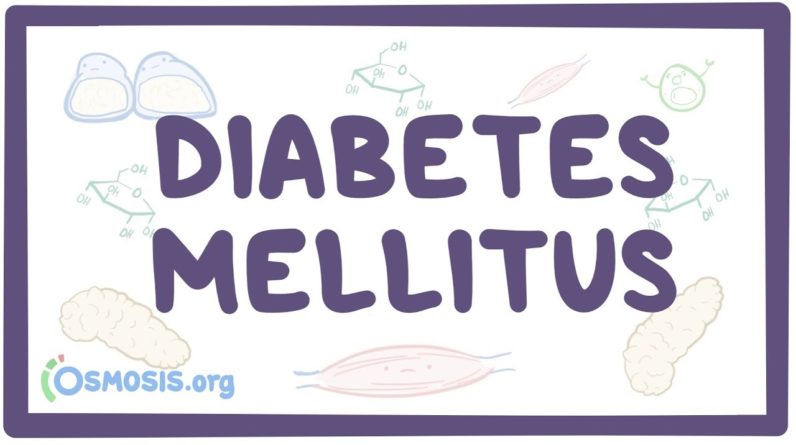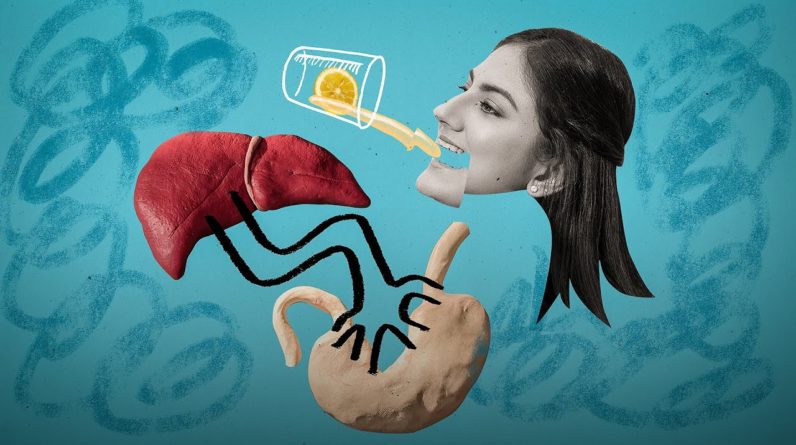
Learning medicine is hard work! Osmosis makes it easy. It takes your lectures and notes to create
a personalized study plan with exclusive videos, practice questions and flashcards, and so
much more. Try it free today! In diabetes mellitus, your body has trouble
moving glucose, which is a type of sugar, from your blood into your cells. This leads to high levels of glucose in your
blood and not enough of it in your cells, and remember that your cells need glucose
as a source of energy, so not letting the glucose enter means that the cells starve
for energy despite having glucose right on their doorstep.
In general, the body controls how much glucose
is in the blood relative to how much gets into the cells with two hormones: insulin
and glucagon. Insulin is used to reduce blood glucose levels,
and glucagon is used to increase blood glucose levels. Both of these hormones are produced by clusters
of cells in the pancreas called islets of Langerhans. Insulin is secreted by beta cells in the center
of the islets, and glucagon is secreted by alpha cells in the periphery of the islets. Insulin reduces the amount of glucose in the
blood by binding to insulin receptors embedded in the cell membrane of various insulin-responsive
tissues like muscle cells and adipose tissue. When activated, the insulin receptors cause
vesicles containing glucose transporter that are inside the cell to fuse with the cell
membrane, allowing glucose to be transported into the cell. Glucagon does exactly the opposite, it raises
the blood glucose levels by getting the liver to generate new molecules of glucose from
other molecules and also break down glycogen into glucose so that it can all get dumped
into the blood. Diabetes mellitus is diagnosed when the blood
glucose levels get too high, and this is seen among 10% of the world population.
There are two types of diabetes – Type 1 and
Type 2, and the main difference between them is the underlying mechanism that causes the
blood glucose levels to rise. About 10% of people with diabetes have Type
1, and the remaining 90% of people with diabetes have Type 2. Let’s start with Type 1 diabetes mellitus,
sometimes just called type 1 diabetes. In this situation, the body doesn’t make
enough insulin. The reason this happens is that in type 1
diabetes there is a type 4 hypersensitivity response or a cell-mediated immune response
where a person’s own T cells attack the pancreas. As a quick review, remember that the immune
system has T cells that react to all sorts of antigens, which are usually small peptides,
polysaccharides, or lipids, and that some of these antigens are part of our own body’s
cells.
It doesn’t make sense to allow T cells that
will attack our own cells to hang around, and so there’s this process to eliminate
them called “self-tolerance”. In type 1 diabetes, there is a genetic abnormality
causes a loss of self-tolerance among T cells that specifically target the beta cell antigens. Losing self-tolerance means that these T cells
are allowed to recruit other immune cells and coordinate an attack on these beta cells. Losing beta cells means less insulin, and
less insulin means that glucose piles up in the blood, because it can’t enter the body’s
cells. One really important genes involved in regulation
of the immune response is the human leukocyte antigen system, or HLA system. Although it’s called a system, it’s basically
this group of genes on chromosome six that encode the major histocompatibility complex,
or MHC, which is a protein that’s extremely important in helping the immune system recognize
foreign molecules, as well as maintaining self-tolerance.
MHC is like the serving platter that antigens
are presented to the immune cells. Interestingly, people with type 1 diabetes
often have specific HLA genes in common with each other, one called HLA-DR3 and another
called HLA-DR4. But this is just a genetic clue right? Because not everyone with HLA-DR3 and HLA-DR4
develops diabetes. In diabetes mellitus type 1, destruction of
beta cells usually starts early in life, but sometimes up to 90% of the beta cells are
destroyed before symptoms crop up. Four clinical symptoms of uncontrolled diabetes,
that all sound similar, are polyphagia, glycosuria, polyuria, and polydipsia. Let’s go through them one by one. Even though there’s a lot of glucose in
the blood, it can’t get into cells, which leaves cells starved for energy, so in response,
adipose tissue starts breaking down fat, called lipolysis, and muscle tissue starts breaking
down proteins, both of which results in weight loss for someone with uncontrolled diabetes.
This catabolic state leaves people feeling
hungry, also known as polyphagia. “Phagia” means eating, and “Poly”
means a lot. Now with high glucose levels, that means that
when blood gets filtered through the kidneys, some of it starts to spill into the urine,
called glycosuria. “Glycos” refers to glucose, “uria”
the urine. Since glucose is osmotically active, water
tends to follow it, resulting in an increase in urination, or polyuria. “Poly” again refers to a lot, and “uria”
again refers to urine again. Finally, because there is so much urination,
people with uncontrolled diabetes become dehydrated and thirsty, or polydipsia. “Poly” means a lot, and “dipsia” means
thirst. Even though people with diabetes aren’t
able to produce their own insulin, they can still respond to insulin, so treatment involves
lifelong insulin therapy to regulate their blood glucose levels and basically enable
their cells to use glucose. One really serious complication with type
1 diabetes is called diabetic ketoacidosis, or DKA. To understand it, let’s go back to the process
of lipolysis, where fat is broken down into free fatty acids.
After that happens, the liver turns the fatty
acids into ketone bodies, like acetoacetic acid and beta hydroxybutyric acid, acetoacetic
acid is a ketoacid because it has a ketone group and a carboxylic acid group. Beta hydroxybutyric acid on the other hand,
even though it’s still one of the ketone bodies, isn’t technically a ketoacid since
its ketone group has been reduced to a hydroxyl group. These ketone bodies are important because
they can be used by cells for energy, but they also increase the acidity of the blood,
which is why it’s called keto-acid-osis. If the blood becoming really acidic can have
major effects throughout the body. Patients can develop Kussmaul respiration,
which is a deep and labored breathing as the body tries to move carbon dioxide out of the
blood, in an effort to reduce its acidity.
Cells also have a transporter that exchanges
hydrogen ions (or protons—H+) for potassium. When the blood gets acidic, it is by definition
loaded with protons that get sent into cells while potassium gets sent into the fluid outside
cells. Another thing to keep in mind is that in addition
to helping glucose enter cells, insulin stimulates the sodium-potassium ATPases which help potassium
get into cells, and so without insulin, more potassium stays in the fluid outside cells. Both of these mechanisms lead to increased
potassium in the fluid outside of cells which quickly makes it into the blood and causes
hyperkalemia. The potassium is then excreted, so over time,
even though the blood potassium levels remain high, overall stores of potassium in the body—which
includes potassium inside cells—starts to run low. Patients will also have a high anion gap,
which reflects a large difference in the unmeasured negative and positive ions in the serum, largely
due to this build up of ketoacids. Diabetic ketoacidosis can happen even in people
who’ve already been diagnosed with diabetes and currently have some sort of insulin therapy.
In states of stress, like an infection, the
body releases epinephrine, which in turn stimulates the release of glucagon. Too much glucagon can tip the delicate hormonal
balance of glucagon and insulin in favor of elevating blood sugars and can lead to a cascade
of events we just described—increased glucose in the blood, loss of glucose in the urine,
loss of water, dehydration, and in parallel a need for alternative energy, generation
of ketone bodies, and ketoacidosis. Interestingly, both ketone bodies break down
into acetone and escape as a gas by getting breathed out the lungs which gives a sweet
fruity smell to a person’s breath.
In general though, that’s the only sweet
thing about this illness, which also causes nausea, vomiting, and if severe, mental status
changes and acute cerebral edema. Treatment of a DKA episode involves giving
plenty of fluids, which helps with dehydration, insulin which helps lower blood glucose levels,
and replacement of electrolytes, like potassium; all of which help to reverse the acidosis. Now, let’s switch gears and talk about Type
2 diabetes, which is where the body makes insulin, but the tissues don’t respond as
well to it. The exact reason why cells don’t “respond”
isn’t fully understood, essentially the body’s providing the normal amount of insulin,
but the cells don’t move their glucose transporters to their membrane in response, which remember
is needed for glucose to get into the cell, these cells therefore they have insulin resistance. Some risk factors for insulin resistance are
obesity, lack of exercise, and hypertension, and the exact mechanisms are still being explored. For example, an excess of adipose tissue—or
fat—is thought to cause the release of free fatty acids and so-called “adipokines”,
which are signaling molecules that can cause inflammation, which seems related to insulin
resistance.

However, many people that are obese are not
diabetic, so genetic factors probably play a major role as well. We see this when we look at twin studies as
well, where having a twin with type 2 diabetes increases the risk of developing type 2 diabetes,
completely independent of other environmental risk factors. In Type 2 diabetes, since tissues don’t
respond as well to normal levels of insulin, the body ends up producing more insulin in
order to get the same effect and move glucose out of the blood. They do this through beta cell hyperplasia,
an increased number of beta cells, and beta cell hypertrophy, where they actually grow
in size, all in this attempt to pump out more insulin. This works for a while, and by keeping insulin
levels higher than normal, blood glucose levels can be kept normal, called normoglycemia. Now, along with insulin, beta cells also secrete
islet amyloid polypeptide, or amylin, so while beta cells are cranking out insulin they also
secrete an increased amount of amylin.
Over time, amylin builds up and aggregates
in the islets. This beta cell compensation, though, isn’t
sustainable, and over time those maxed out beta cells get exhausted, and they become
dysfunctional, and undergo hypotrophy and get smaller, as well as hypoplasia and die
off. As beta cells are lost and insulin levels
decrease, glucose levels in the blood start to increase, and patients develop hyperglycemia,
which leads to similar clinical signs that I mentioned before, like polyphagia, glycosuria,
polyuria, and polydipsia. But unlike type 1 diabetes, there is generally
some circulating insulin in type 2 diabetes from the beta cells that are trying to compensate
for the insulin resistance. This means that the insulin/glucagon balance
is such that diabetic ketoacidosis doesn’t usually develop. Having said that, a complication called hyperosmolar
hyperglycemic state (or HHS) is much more common in type 2 diabetes than type 1 diabetes
– and it causes increased plasma osmolarity due to extreme dehydration and concentration
of the blood.
To help understand this, remember that glucose
is a polar molecule that cannot passively diffuse across cell membranes, which means
that it acts as a solute. So when levels of glucose are super high in
the blood (meaning it’s a hyperosmolar state), water begins to leave the body’s cells and
enter the blood vessels, leaving the cells relatively dry and shriveled rather than plump
and juicy. Blood vessels that are full of water lead
to increased urination and total body dehydration. And this is a very serious situation because
the dehydration of the body’s cells and in particular the brain can cause a number
of symptoms including mental status changes. In HHS, you can sometimes see mild ketonemia
and acidosis, but not to the extent that it’s seen in DKA, and in DKA you can see some hyperosmolarity,
so there is definitely overlap between these two syndromes. Besides type 1 and type 2 diabetes, there
are also a couple other subtypes of diabetes mellitus. Gestational diabetes is when pregnant women
have increased blood glucose which is particularly during the third trimester. Although ultimately unknown, the cause is
thought to be related to pregnancy hormones that interfere with insulin’s action on
insulin receptors.
Also, sometimes people can develop drug-induced
diabetes, which is where medications have side effects that tend to increase blood glucose
levels. The mechanism for both of these is thought
to be related to insulin resistance (like type 2 diabetes), rather than an autoimmune
destruction process (like in type 1 diabetes). Diagnosing type 1 or type 2 diabetes is done
by getting a sense for how much glucose is floating around in the blood and has specific
standards that the World Health Organization uses. Very commonly, a fasting glucose test is taken
where the person doesn’t eat or drink (except water, that’s okay) for 8 hours and has
their blood tested for glucose levels. Levels of 100 110 milligrams per deciliter
to 125 milligrams per deciliter indicates prediabetes and 126 milligrams per deciliter
or higher indicates diabetes. A non-fasting or random glucose test can be
done at any time, with 200 milligrams per deciliter or higher being a red flag for diabetes. Another test is called an oral glucose tolerance
test, where a person is given glucose, and then a blood samples are taken at time intervals
to figure out how well it’s being cleared from the blood, the most important interval
being 2 hours later.
Levels of 140 milligrams per deciliter to
199 milligrams per deciliter indicate prediabetes and 200 or above indicates diabetes. Another thing to know is that when blood glucose
levels get high, the glucose can also stick to proteins that are floating around in the
blood or in cells. So that brings us to another type of test
that can be done which is the HbA1c test, which tests for the proportion of hemoglobin
in red blood cells that has glucose stuck to it – called glycated hemoglobin. HbA1c levels of 5.7% to 6.4% indicates prediabetes,
and 6.5% or higher indicates diabetes. This proportion of glycated hemoglobin doesn’t
change day to day, so it gives a sense for whether the blood glucose levels have been
high over the past 2 to 3 months. Finally, we have the C-peptide test, which
tests for this byproduct of insulin production.
If the level of C-peptide is low or absent,
it means the pancreas is no longer producing enough insulin, and the glucose can’t enter
the cells. For type I diabetes, insulin is the only treatment
option. For type II diabetes, on the other hand, lifestyle
changes, like weight loss and exercise, along with a healthy diet and oral antidiabetic
medications, like metformin and several other classes, can sometimes be enough to reverse
some of that insulin resistance and keep blood sugar levels in check. However, if oral antidiabetic medications
fail, type II diabetes can also be treated with insulin. Something to bear in mind is that insulin
treatment comes with a risk of hypoglycemia, especially if insulin is taken without a meal. Symptoms of hypoglycemia can be mild, like
weakness, hunger, shaking, but they can progress to loss of consciousness and seizures in severe
cases. In mild cases, drinking juices, or eating
candy, or sugar, may be enough to bring blood sugar up. But in severe cases, intravenous glucose should
be given as soon as possible. The FDA has also recently approved intranasal
glucagon as a treatment for severe hypoglycemia.
Ok, now, over time, high glucose levels can
cause damage to tiny blood vessels, called the microvasculature. In arterioles, a process called hyaline arteriolosclerosis
where the walls of arterioles where they develop hyaline deposits, these deposits of proteins,
and these make them hard and inflexible. In capillaries, the basement membrane can
thicken and make it hard for oxygen to easily move from the capillary to the tissues, causing
hypoxia. One of the most significant effects is that
diabetes increases the risk of medium and large arterial wall damage and subsequent
atherosclerosis, which can lead to heart attacks and strokes, major causes of morbidity and
mortality for patients with diabetes.
In the eyes, diabetes can lead to retinopathy
and evidence of that can be seen on a fundoscopic exam that shows cotton wool spots or flare
hemorrhages – and can eventually cause blindness. In the kidneys, the afferent and efferent
arterioles, as well as the glomerulus itself can get damaged which can lead to a nephrotic
syndrome that slowly diminishes the kidney’s ability to filter blood over time – and can
ultimately lead to dialysis. Diabetes can also affect the function of nerves,
causing symptoms like a decrease in sensation in the toes and fingers, sometimes called
a stocking-glove distribution, as well as causing the autonomic nervous system to malfunction,
and that system controls a number of body functions – everything from sweating to passing
gas. Finally, both the poor blood supply and nerve
damage, can lead to ulcers (typically on the feet) that don’t heal quickly and can get
pretty severe, and need to be amputated.
These are some of the complications of uncontrolled
diabetes, which is why it’s so important to, diagnose and control diabetes through
a healthy lifestyle, medications to reduce insulin resistance and even insulin therapy
if beta cells have been exhausted. While type 1 diabetes can not be prevented,
type 2 diabetes can. In fact, many people with diabetes can control
their blood sugar levels really effectively and live a full and active life without any
of the complications..







